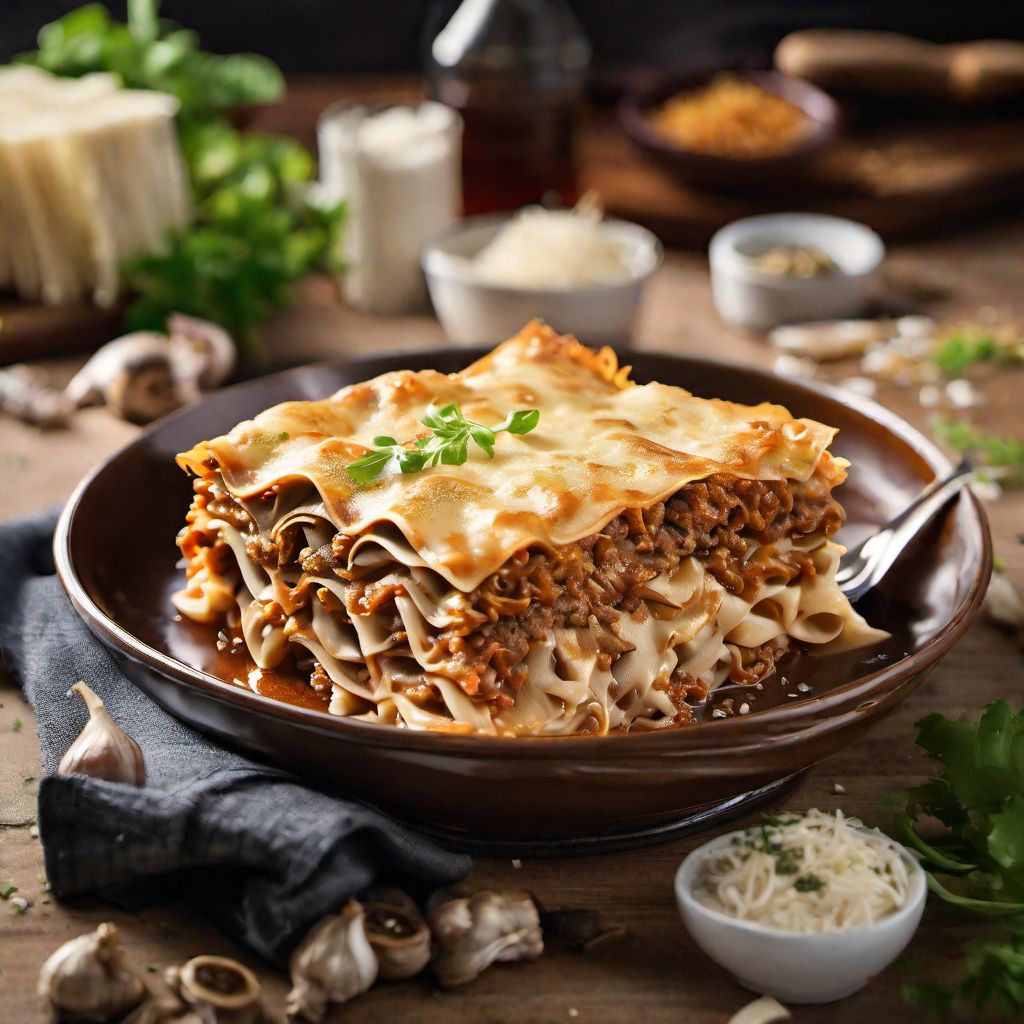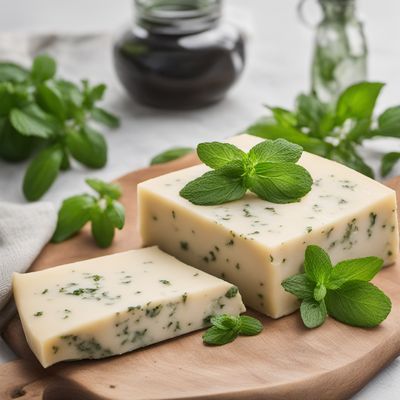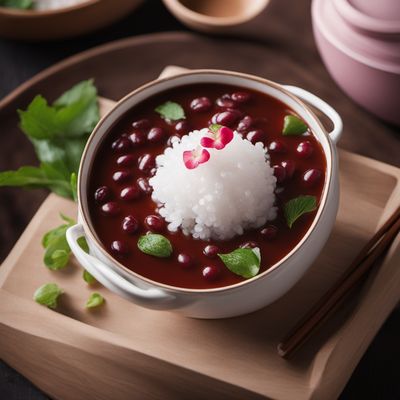
Recipe
Japanese-style Lasagne
Sakura Lasagne: A Fusion of Italian and Japanese Flavors
4.9 out of 5
In the context of Japanese cuisine, this Japanese-style Lasagne combines the rich and comforting flavors of traditional Italian lasagne with a touch of Japanese influence. The result is a unique fusion dish that marries the umami of miso and soy sauce with the creamy layers of lasagne noodles and cheese.
Metadata
Preparation time
30 minutes
Cooking time
30 minutes
Total time
60 minutes
Yields
4 servings
Preparation difficulty
Medium
Suitable for
Omnivore, Pescatarian (if pork is substituted with seafood or tofu), Dairy-free (if cheese is omitted or substituted with dairy-free alternatives), Low-carb (if lasagne noodles are substituted with zucchini or eggplant slices), Gluten-free (if gluten-free lasagne noodles are used)
Allergens
Wheat (if using regular lasagne noodles), Dairy (if using cheese)
Not suitable for
Vegetarian (contains pork), Vegan (contains pork, dairy, and eggs)
Ingredients
While the original Italian lasagne typically features ingredients like ground meat, tomato sauce, and mozzarella cheese, this Japanese adaptation incorporates Japanese flavors such as miso, soy sauce, and Japanese mushrooms. The dish also incorporates Japanese cooking techniques and presentation styles to create a harmonious blend of both cuisines. We alse have the original recipe for Lasagne, so you can check it out.
-
9 lasagne noodles 9 lasagne noodles
-
1 tablespoon vegetable oil (15ml) 1 tablespoon vegetable oil (15ml)
-
1 onion, finely chopped 1 onion, finely chopped
-
2 cloves garlic, minced 2 cloves garlic, minced
-
200g ground pork (7oz) 200g ground pork (7oz)
-
200g mixed Japanese mushrooms (shiitake, enoki, shimeji) (7oz) 200g mixed Japanese mushrooms (shiitake, enoki, shimeji) (7oz)
-
2 tablespoons miso paste (30g) 2 tablespoons miso paste (30g)
-
2 tablespoons soy sauce (30ml) 2 tablespoons soy sauce (30ml)
-
1 cup chicken broth (240ml) 1 cup chicken broth (240ml)
-
1 cup heavy cream (240ml) 1 cup heavy cream (240ml)
-
1 cup shredded mozzarella cheese (120g) 1 cup shredded mozzarella cheese (120g)
-
1/4 cup grated Parmesan cheese (25g) 1/4 cup grated Parmesan cheese (25g)
-
Salt and pepper to taste Salt and pepper to taste
Nutrition
- Calories: 450 kcal / 1880 KJ
- Fat: 28g (14g saturated)
- Carbohydrates: 28g (6g sugars)
- Protein: 24g
- Fiber: 3g
- Salt: 1.5g
Preparation
-
1.Preheat the oven to 180°C (350°F).
-
2.Cook the lasagne noodles according to the package instructions until al dente. Drain and set aside.
-
3.In a large skillet, heat the vegetable oil over medium heat. Add the chopped onion and minced garlic, and sauté until translucent.
-
4.Add the ground pork to the skillet and cook until browned.
-
5.Add the mixed Japanese mushrooms to the skillet and cook until they release their moisture.
-
6.In a small bowl, whisk together the miso paste, soy sauce, chicken broth, and heavy cream. Pour the mixture into the skillet and bring to a simmer. Cook for 5 minutes, stirring occasionally.
-
7.Season the mixture with salt and pepper to taste.
-
8.In a greased baking dish, layer 3 lasagne noodles, followed by a layer of the pork and mushroom mixture. Repeat this process two more times, ending with a layer of the pork and mushroom mixture on top.
-
9.Sprinkle the shredded mozzarella cheese and grated Parmesan cheese evenly over the top layer.
-
10.Bake in the preheated oven for 25-30 minutes, or until the cheese is golden and bubbly.
-
11.Remove from the oven and let it cool for a few minutes before serving.
Treat your ingredients with care...
- Lasagne noodles — Cook the noodles until al dente to ensure they hold their shape in the lasagne.
- Japanese mushrooms — Clean the mushrooms gently with a damp cloth to remove any dirt before cooking.
- Miso paste — Use a good quality miso paste for the best flavor. Adjust the amount according to your taste preference.
Tips & Tricks
- For a vegetarian version, substitute the ground pork with crumbled tofu or cooked seafood like shrimp or crab.
- Experiment with different types of Japanese mushrooms to add depth of flavor to the dish.
- If you prefer a lighter version, use low-fat milk instead of heavy cream.
- Add a sprinkle of furikake (Japanese rice seasoning) on top before serving for an extra burst of flavor.
- Leftovers can be stored in the refrigerator for up to 3 days and reheated in the oven or microwave.
Serving advice
Serve the Japanese-style Lasagne hot, straight from the oven. Garnish with chopped green onions or fresh herbs like cilantro or parsley for a pop of color. Accompany with a side salad or pickled vegetables to balance the richness of the dish.
Presentation advice
When plating, use a square or rectangular dish to showcase the layers of the lasagne. Cut into individual portions and serve on plates or shallow bowls. Drizzle a little soy sauce or miso glaze on the plate for an elegant touch.
More recipes...
For Lasagne » Browse all
For Italian cuisine » Browse all
More Italian cuisine dishes » Browse all

Crespelle al Bitto
Crespelle al Bitto is a traditional Italian dish that is typically served as a main course. This savory dish is made with crepes, a rich cheese...

Pollo in potacchio
Chicken with Tomato and Rosemary
Pollo in potacchio is a classic Italian dish that is perfect for a cozy dinner at home. The dish is made with chicken that is cooked in a...

Gelato al melone
Melon Gelato
Gelato al melone is a refreshing Italian dessert that is perfect for hot summer days. The dessert is made with fresh cantaloupe, cream, and sugar,...
More Japanese cuisine dishes » Browse all

Chikuzenni
Simmered Chicken and Vegetables
Chikuzenni is a traditional Japanese dish that is typically served during the New Year's holiday. It is a flavorful and nutritious stew that is...

Ika sōmen
Squid with Somen Noodles
Ika sōmen is a Japanese dish that features thinly sliced squid served with somen noodles. The dish is typically served as a light and refreshing...

Ebi furai
Fried Shrimp
Ebi furai is a Japanese dish that consists of breaded and deep-fried shrimp. It is typically served as an appetizer or side dish.











